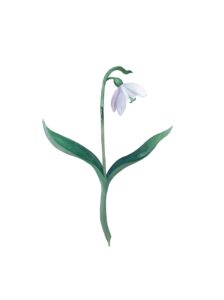 First Flower of Her Kind: Plath and Snowdrops
First Flower of Her Kind: Plath and Snowdrops
By Flora Meeker (’25)
Content Warning: this post contains references to mental illness.
It was the kind of morning where the air still bites and life is yet to bleed its way back into the world. The sky is still the dismal gray of early February, the flat, blank expanse of sky holding no texture, no depth. Days like this when the sky just seems to end, I understand Sylvia Plath’s metaphor of the bell jar. Winter is not an easy time, especially when one’s mind is already susceptible to downturns and spirals. When the world is not lush and deeply green I feel myself stumble. By mid-February I am in a deep pit longing for release, but winter traps me under suffocating glass. But once again to use Plath’s most famous metaphor, with the sight of that first flower, the snowdrop, the bell jar lifts.
Snowdrops (Galanthus spp.) are often the first flowers to bloom in spring. They are small, bulbous, perennial plants belonging to the family Amarillydaceae. Snowdrops typically have two (occasionally three) basal linear leaves that emerge in late December, and a white, bell-shaped, drooped flower that normally blooms around February or April. The flowers have six petal-like tepals in two whorls of three, and then an inner whorl of true petals with green markings. The genus Galanthus includes 22 accepted species, with the species most common in cultivation being Galanthus nivalis, which is native to Central Asia and widely naturalized in Europe and North America.
For those who struggle with seasonal affective disorder or depression, the first flower of spring can bring a much-needed sense of relief and optimism. In the midst of a dark and dreary winter, it can be easy to feel trapped and suffocated, as though there is no escape from the weight of one’s own thoughts and emotions. Plath’s image of the bell jar is a poignant one, suggesting a sense of being trapped, cut off from the world outside. But the snowdrop, with its delicate white petals, can be a symbol of breaking free, of pushing past the confines of the jar and reaching towards a new light. The first flower of spring, a sign that the earth is awakening from its slumber and beginning to bloom once more. It is a reminder that even in the darkest of times, there is always the possibility of growth and of renewal.
The snowdrop for its ephemeralness, occupies a large space in the cultural botanical imagination. In literature as early as Homer’s Odyssey, snowdrops have been used as a symbol of hope and renewal or healing in literature. References to snowdrops appear in British pastoral poems as symbols standing as a representation of new life and rebirth as well as resilience. However, for Sylvia Plath, they occupy liminal space—like Plath herself. In Plath’s work, such as the late poem “Child,” the snowdrop takes on a deeper significance, representing not only the promise of new life but also the fragility of existence and the inevitability of death. While they are certainly a sign of approaching spring, they serve as a herald of hope, but not the promise of it. Like its ephemeral blooms, the snowdrop provides the momentary glimpse into what the future may hold—the very edge where hope collides with despair.
The use of snowdrops as a symbol makes perfect sense for a writer like Plath. Snowdrops sit on a precipice in the messy, unsure place between winter and spring. They are beautifully resilient, blooming where other flowers freeze, able to withstand being buried under the snow. I see a deep kinship between Plath and snowdrops, as both share a similar cyclical nature. Snowdrops are known for their perennial habit, meaning they come back year after year, blooming in late winter or early spring. Similarly, Sylvia Plath’s writing also exhibits a cyclical nature, with periods of intense activity followed by periods of dormancy or inactivity. This pattern is mirrored in her mental wellness, with periods of stability and productivity followed by periods of depression and emotional turmoil. Just as snowdrops bloom in harsh winter conditions, Plath’s writing often explores themes of struggle and pain, delving into the dark and difficult aspects of the human experience. Plath confronts the realities of mental illness, trauma, and personal struggle, creating works that are both haunting and deeply introspective while preserving the hope of the perennial snowdrop and a new bloom.
Works Cited